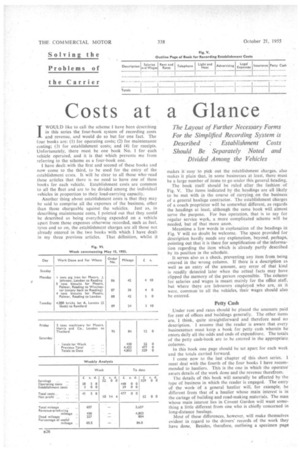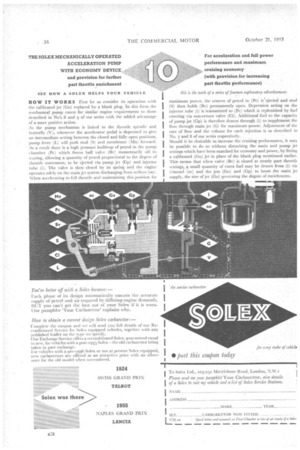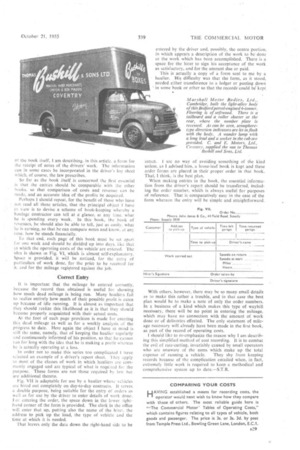Costs at a Glance
Page 60

Page 62

Page 63

If you've noticed an error in this article please click here to report it so we can fix it.
IWOULD like to call the scheme I have been describing in this series the four-book system of recording costs and revenue, and would do so but for one fact. The four books are: (1) for operating costs; (2) for maintenance costing; (3) for establishment costs; and (4) for receipts. Unfortunately, there must be one book No. 1 for each vehicle operated, and it is that which prevents me from referring to the scheme as a four-book one.
I have dealt with the first and second of these hooks and now come to the third, to be used for the entry of the establishment costs. It will be clear to all those who read these articles that there is no need to have one of these books for each vehicle. Establishment costs are common to all the fleet and are to be divided among the individual vehicles in proportion to their load-carrying capacity.
Another thing about establishment costs is that they may be said to comprise all the expenses of the business, other than those chargeable against the vehicles. Just as, in describing maintenance costs, 1 pointed out that they. could be described as being everything expended on a vehicle apart from those expenses otherwise recorded, such as fuel, Lyres and so on, the establishment charges are all those not already entered in the two books with which 1 have dealt in my three previous articles. That definition, whilst it makes it-easy to pick out the establishment charges, also makes it plain that, in some businesses at least, there must be a large number of items to go under this general heading.
The book itself should be ruled after the fashion of Fig. V. The items indicated by the headings are all likely to be met with in the course of carrying, on the business of a general haulage contractor. The establishment charges of a coach proprietor will be somewhat different, as regards the headings at least, although the same book will almost serve the purpose. For bus operation, that is to say for regular service work, a more complicated scheme will be needed, but of that more anon.
Meantime a few words in explanation of the headings in Fig. V will no doubt be welcome. The space provided for description hardly needs any explanation, beyond, perhaps, pointing out that it is there for amplification of the information regarding the item which is already partly described by its position in the schedule.
It serves also as a check, preventing any item from being entered in the wrong column. If there is a description as well as an entry of the amount, any error of that kind is readily detected later when the actual facts may have slipped the memory of the person responsible. The column for salaries and wages is meant mainly for the office staff, but where there are labourers employed who are, as it were, common to all the vehicles, their wages should also be entered.
Petty Cash
Under rent and rates should be placed the amounts paid for rent of offices and buildings generally. The other items are, I think, quite straightforward and therefore need no description. I assume that the reader is aware that every businessman must keep a book for petty cash wherein he enters daily all the odds and ends of expenditure. The totals of the petty cash-book are to be entered in the appropriate columns.
In this book one page should be set apart for each week and the totals carried forward.
I come now to the last chapter of this short series. I must deal with the fourth of the four books 1 have recommended to hauliers. This is the one in which the operator enters details of the work done and the revenue therefrom.
The details of this book will naturally be affected by the type of business in which the reader is engaged. The entry of the workof a general haulier will, for example, be different from that of a haulier whose main interest is in the cartage of building and road-making materials. The man whose main interest lies in Covent Garden will want something a little different from one who is chiefly concerned in long-distance haulage.
Most of these differences, however, will make themselves evident in regard to the drivers' records of the work they have done. Besides, therefore, outlining a specimen page
HOW IT WORKS First let us consider its operation with the calibrated jet (Gu) replaced by a blank plug. In this form the mechanical pump caters for similar engine requirements to those described in No's 8 and 9 of our series with the added advantage of a more positive action.
As the pump mechanism is linked to the throttle spindle and butterfly (V), whenever the accelerator pedal is depressed to give an intermediate setting between the closed and fully open positions, pump lever (L) will push stud (S) and membrane (Mn) forward. As a result there is a high pressure build=up of petrol in the pump chamber (Pc) which forces ball valve (BY) momentarily off its seating, allowing a quantity of petrol proportional to the degree of throttle movement, to be ejected via pump jet (Gp) and injector tube (i). The valve is then closed by its spring and the engine operates solely on the main jet system discharging from orifices (oo). When accelerating to full throttle and maintaining this position for maximum power, the reserve of petrol in (Pc) is'ejected and stud (S) then holds (By) permanently open. Depression acting on the injector tube (i) is transmitted to (Pc) which is replenished by fuel entering via non-return valve (Ci). Additional fuel to the capacity of pump jet (Gp) is therefore drawn through (i) to supplement the flow through main jet (G) for maximum power. Adjustment of the rate of flow and the volume for each injection is as described in No. 7 and 8 of OUT series respectively.
Should it be desirable to increase the cruising performance, it ma be possible to do so without disturbing the main and pump jet settings which have been matched for economy and power, by fitting a calibrated (Gu) jet in place of the blank plug mentioned earlier, This means that when valve (By) is closed at. steady part throtth settings, a small quantity of extra fuel may be drawn from (i) viz channel (cc) and the jets (Gul and (Gp) to boost the main jet supply, the size of jet (Go) governing the degree of enrichment.,
ot the book itself, I am describing, in this article, a form for the receipt of notes of the drivers' work. The information can in some cases be incorporated in the driver's log sheet which, of course, the law prescribes_ So far as the book itself is concerned the first essential is that the entries should be comparable. with the other books, so that comparison of costs and revenue can be made, and an accurate idea of the profits be acquired.
Perhaps! should repeat, for the benefit of those who have not read all these articles, that the principal obiect I have in view is to devise a scheme of book-keeping whereby a haulage contractor can tell at a' glance, at any time, what he is spending every week. In this book, the book of revenues, he should also be able to tell, just as easily, what he is earning, so that.he can compare notes and know, at any time. how he stands financially.
To that end, each page of this book must be set apart for one week and should be divided up into days. like that in which the operating costs. of the vehicle'are entered. 'The idea is shown in rig. VI, which is almost self-explanalory. Space is provided, it will be noticed, for the entry of particulars of work done, for the price to: be received for it. and for the Mileage registered againSt the job.
It is important that the mileage be entered correctly, because the record thus obtained is useful for showing how much dead mileage is being run. Many hauliers fail to realize entirely how much of their possible profit is eaten up because of idle running, It is almost as important that they should realize_ this likelihood as it is that they should become properly acquainted with their actual costs.
At the foot of each page provision is made for entering this dead mileage as well as for a weekly analysis of the progress to date. Here again the object T have in mind is still the same, namely, that of keeping the haulier regularly and continuously informed of his position, so that he cannot run for long with the idea that he is making a profit whereas he is actually operating at a loss.
In order not to make this series too complicated I have selected an example of a driver's report sheet. 'I hey apply Ii) most of the classes of work in which hauliers are commonly engaged and arc typical of what is required for the purpose. These forms are not those required by law hot are additional thereto.
Fig. VII is adaptable for use by a haulier whose vehicles :lie hired out completely on day-to-day contracts. It serves a double purpose, being suitable for the entry of orders as well as for use by the driver to enter details of work done. For entering the order, the space down in the lower righthand corner of the form is provided. The clerk in the office wilt enter that up, putting also the name of the hirer, the address to pick up the load, the type of vehicle and the time at which it is needed.
That leaves only the data down the right-hand side to be HAVING established a means for recording costs, the operator would next wish to know how they compare with those of others. The most reliable guide here is '"The Commercial Motor' Tables of Operating Costs," which contains figures relating to all types of vehicle, both goods and passenger. The price is 3s. or 3s. 3d. by post from Temple Press Ltd., Bowling Green Lane, London, E.C.1.




































































































